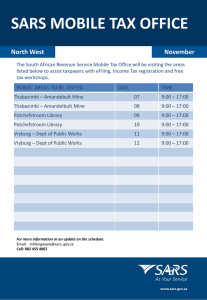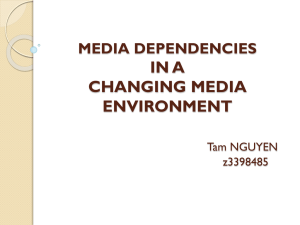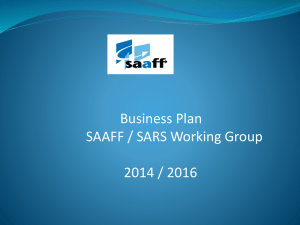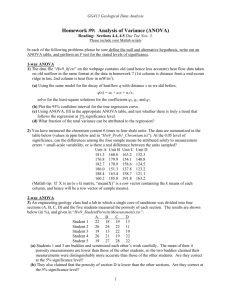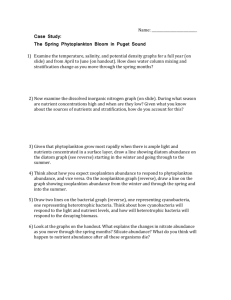Portage connectivity does not predict establishment success of
advertisement
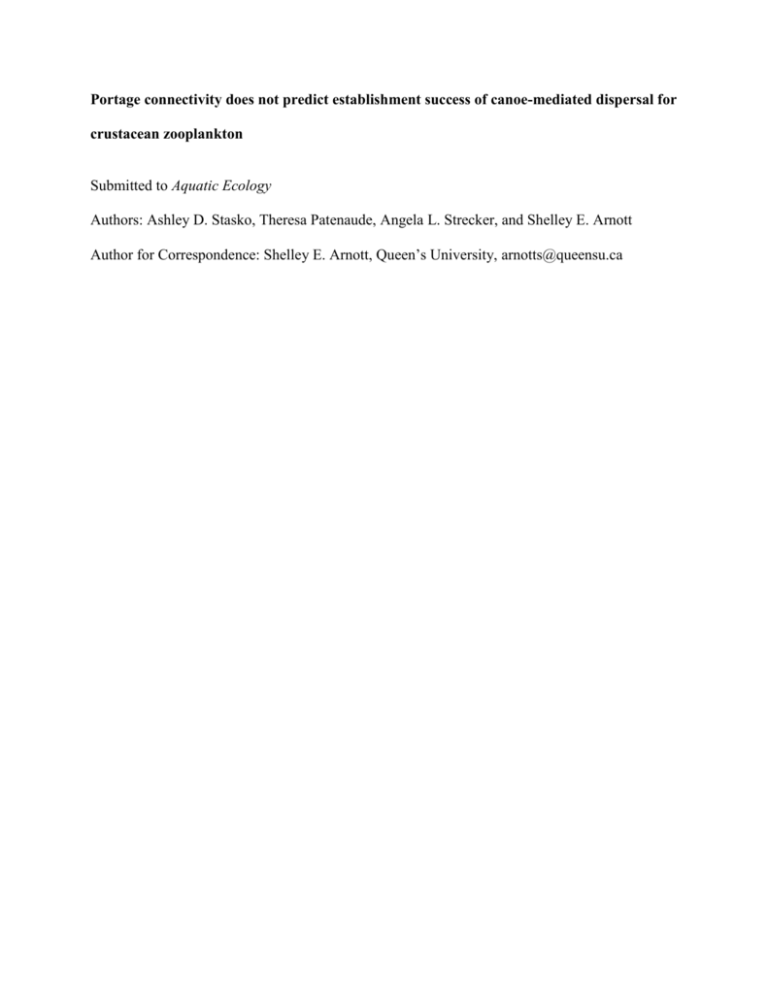
Portage connectivity does not predict establishment success of canoe-mediated dispersal for crustacean zooplankton Submitted to Aquatic Ecology Authors: Ashley D. Stasko, Theresa Patenaude, Angela L. Strecker, and Shelley E. Arnott Author for Correspondence: Shelley E. Arnott, Queen’s University, arnotts@queensu.ca ONLINE RESOURCE 1 Total abundance (#), species richness, and Simpson’s diversity in cattle tanks seeded with zooplankton rinsed from the hulls of canoes after simulated portage durations of 5, 10, 15, 20, and 30 min, as well as controls (did not receive zooplankton) after a 6 week incubation Richness Simpson’s Diversity 11 17 8 6 7 5 0.78 0.76 0.69 5 min 107 35 28 535 979 9 560 5 5 13 5 4 0.58 0.54 0.69 0.48 0.21 10 min 5 244 6 833 3 615 56 9 180 4 5 5 7 5 0.06 0.32 0.34 0.68 0.11 15 min 142 675 133 1 844 2 466 4 8 9 8 3 0.25 0.50 0.72 0.46 0.14 20 min 48 30 140 1 427 110 620 1 5 7 9 6 0 0.59 0.64 0.74 0.07 30 min 25 3 902 4 707 17 175 4 705 5 1 3 9 4 0.59 0 0.05 0.70 0.06 Control 914 34 18 297 1 5 5 2 8 1 0.25 0.60 0.50 0.75 0 Treatment Initial Hull Samples Total Abundance (#) ONLINE RESOURCE 2 Results of single-factor ANOVAs of log10-transformed richness, Simpson’s diversity, log10-transformed first (PCA1) and second (PCA2) principal components analysis axis scores, and log10-transformed abundances by treatment. Results from ANOVAs (p(ANOVA)) were combined with ordered heterogeneity tests (Rice and Gaines 1994) to yield an rsPc statistic and a corresponding p(OH) that tests against directional alternative hypotheses (significant at p < 0.05) Type of ANOVA Between Groups DF Within Groups DF F P(ANOVA) rsPc P(OH) Richness Normal ANOVA 6 26 0.62 0.71 0.24 0.26 Simpson's diversity Normal ANOVA 6 26 1.18 0.35 0.19 0.32 PCA1 axis scores Normal ANOVA 6 26 3.75 0.008 0.005 0.96 PCA2 axis scores Welch's ANOVA 6 26 5.64 0.008 0.014 0.94 Abundance Welch’s ANOVA 5 24 1.32 0.32 0.15 0.44 ONLINE RESOURCE 3 Presence (+) of crustacean zooplankton species in George Lake (combined data of this study and Schartau et al. 2007) and in initial samples rinsed from canoes hulls (2009), as well as the treatment frequency, global frequency, and highest relative abundance at which each species occurred. Cyclopoid copepods were only identified to species for one pond per treatment, thus only presence and the relative abundance at which they occurred is noted. Treatment and global frequencies were instead calculated for the pooled category Unidentified Cyclopoid spp. Blank spaces indicate the species was not found in that treatment. Species codes used in ordination biplots of principal components analyses scores (Fig. 3, Fig. 4) are also indicated Species Code Initial Samples Treatment Frequency George Lake 5 min 10 min 15 min 20 min 30 min 0.8 0.6 0.6 1 0.6 Global Frequency Highest Relative Abundance 0.72 >50% 0.04 1-10% 0.08 1-10% 0.04 1-10% 0.2 10-50% 0.08 10-50% 0.08 1-10% 0.04 1-10% Control CLADOCERA Bosminidae Bosmina sp. Baird a Bos Bos sp. + + Eubosmina (Neobosmina) tubicen (Brehm) Chydoridae 0.2 Chy Acroperus harpae (Baird) + Alona affinis (Leydig) + Alona bicolor Frey + Alona costata Sars + Alona gutatta Sars Alo gut + Alona rectangula Sars Alonella acutirostris Birge Alonella exigua (Fischer) + a 0.2 0.2 0.2 0.4 0.2 0.2 0.2 0.2 + All acu + + + Alonella nana Baird Chydorus piger (Sars) 0.2 0.2 0.2 + pooled group including B. leideri De Melo and Hebert, and B. (Eubosmina) freyi De Melo and Hebert 0.2 Species Code Initial Samples 5 min Chydorus sphaericus Müller Eurycercus lamullatus Müller + Pleroxus hastatus Sars Highest Relative Abundance 10 min 0.24 10-50% 0.2 10-50% 0.2 0.16 >50% 0.2 0.08 1-10% 0.04 >50% 0.04 1-10% 0.4 0.04 1-10% 15 min 20 min 30 min Control 0.6 0.2 0.2 0.2 + Eur lam 0.2 Monospilus dispar Sars Global Frequency Treatment Frequency George Lake + Plx has Rhynchotalona falcata Sars 0.4 + + + + 0.6 0.2 0.4 Daphniidae Daphnia (Daphnia) ambigua Scourfield Dph amb Daphnia (Hyalodaphnia) mendotae Birge Dph men Scapholeberis kingi (Sars) Sca kin 0.2 + 0.2 0.4 Holopedidae Holopedium glacialis Rowe b + 0.2 Macrothricidae Acantholeberis curvirostris (O.F.M.) Ophryoxus gracilis Sars + Oph gra + 0.2 Ilyocryptidae Ilyocryptus spinifer Herrick + Polyphemidae Polyphemus pediculus (Linnaeus) Sididae Pol ped + + 0.2 1 1 0.2 0.2 0.4 0.16 >50% 0.8 0.8 0.4 0.92 >50% Sid Diaphanosoma birgei Kořínek + Latona setifera (O.F.M.) + Sida crystallina (O.F.M.) b 0.2 Sida cry previously referred to as H. gibberum (Rowe 2000) + + 1 Species Code Initial Samples Treatment Frequency George Lake Global Frequency Highest Relative Abundance 5 min 10 min 15 min 20 min 30 min Control + 0.6 0.4 0.6 0.6 0.4 0.2 0.52 >50% + 0.8 0.4 0.6 0.8 0.4 0.8 0.6 10-50% 0.4 0.4 0.2 0.4 0.2 10-50% + + + + COPEPODA Nauplii + Copepodid Harpacticoida Harpacticoid sp. + Calanoida Epischura lacustris S.A. Forbes Leptodiaptomas minutus Lilljeborg + Lep min Skistodiaptomus oregonensis Lilljeborg + + Cyclopoida Acanthocyclops sp. Fischer c Diacyclops bicuspidatus thomasi Forbes Eucyclops elegans Herrick + + + + >50% + d + 10-50% Eucyclops prinophorus Kiefer + Macrocyclops albidus (Jurine) + Mesocyclops edax S.A. Forbes + + Microcyclops rubellus (Lilljeborg) + + 1-10% Orthocyclops modestus Herrick + Paracyclops fimbriatus poppei Rehberg + + >50% Tropocyclops extensus Kiefer + Unidentified Cyclopoid sp. Cyclo sp. + 0.6 0.4 0.8 0.6 + <1% + 1-10% 0.4 0.8 0.56 100% c Includes members of the Acanthocyclops vernalis complex. According to Hudson et al. (1998), A. brevispinosus and A. robustus are the only two species that can be positively differentiated in Ontario, however difficulties in distinguishing even these two necessitated the pooling of species to genus level. d formerly referred to as E. serrulatus (Hudson et al. 1998)
